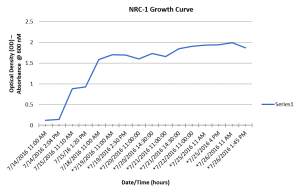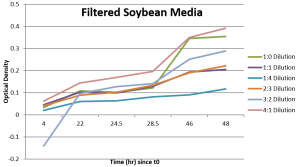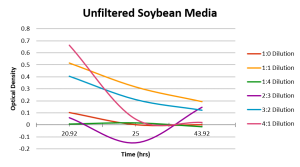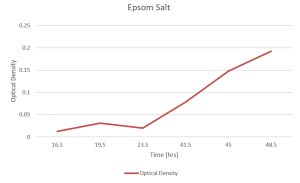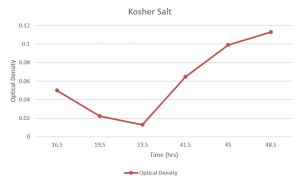Finding Low Cost Substitutes for Ingredients used in Complete Media for Halobacterium salinarum
By Sumaiya Sathar
Introduction
Halobacterium salinarum is a type of archaea that resides in highly salty environments. H. salinarum is widely used as a model organism since their genetic processing method is very similar to that of humans. In a laboratory setting, halobacterium is grown in Complete Media which is a combination of laboratory-grade chemicals and proteins that provide the nutrients H. salinarum needs in order to survive. Halobacterium is extremely simple to conduct experiments with and safely handle, thus making it a favorite amongst teachers around the world. The ingredients used in complete media are expensive and inaccessible for many teachers and aspiring scientists, so our goal is to find accessible and low cost ingredients to use as substitutes for the more expensive chemicals in complete media. Throughout the Internship my partners Sara, Nida and I have been testing various substitutes that teachers could use to prepare low cost media.
Materials and Methods
To conduct these tests:
1.Substitute one ingredient from standard CM. In each case, we began by substituting the same mass of the substitute ingredient as is used in standard media.
2.Complete a growth curve experiment.
a.Add 5 mL of the media to four separate 14 mL falcon tubes.
b.Add 100 uL of wild type Halobacterium to three of the tubes. Do not add cells to the fourth tube – this tube will serve as your control.
c.Place the falcon tubes in a shaking incubator (220 rpm) at 37°C with light.
d.Take the optical density (OD) of the sample every 4 hours for a 48 hour time period. When measuring OD, use absorbance at 600 nm.
e.Graph the results and formulate our conclusions.
Below is a chart of all the ingredients found in regular CM media and the substitutes we tested.
Above is a graph of the growth curve for Halobacterium in regular complete media, without any substitutes. The growth curves for Halobacterium in media with substitutes were compared to this growth curve in order to determine if the substitute did indeed work or not.
Results
Filtered soybeans work perfectly for Halobacterium. Halo showed a beautiful growth pattern.
Unfiltered soybeans do not work. Large chunks of soybean interfered with the optical densities.
This graph compares whey media isolate and whey protein powder. Both show an increase from original values but have many dips along the way. The data was inconsistent and thus unreliable.
Epsom Salt result in a steady increase of halo population and thus we can conclude that it works.
Kosher Salt gave us beautiful results. The growth curve shows an increase in halo.
Future Work
In the future we hope to find substitutes for sodium citrate as well as conduct the experiments with whey media again after filtering the media to get better results.


